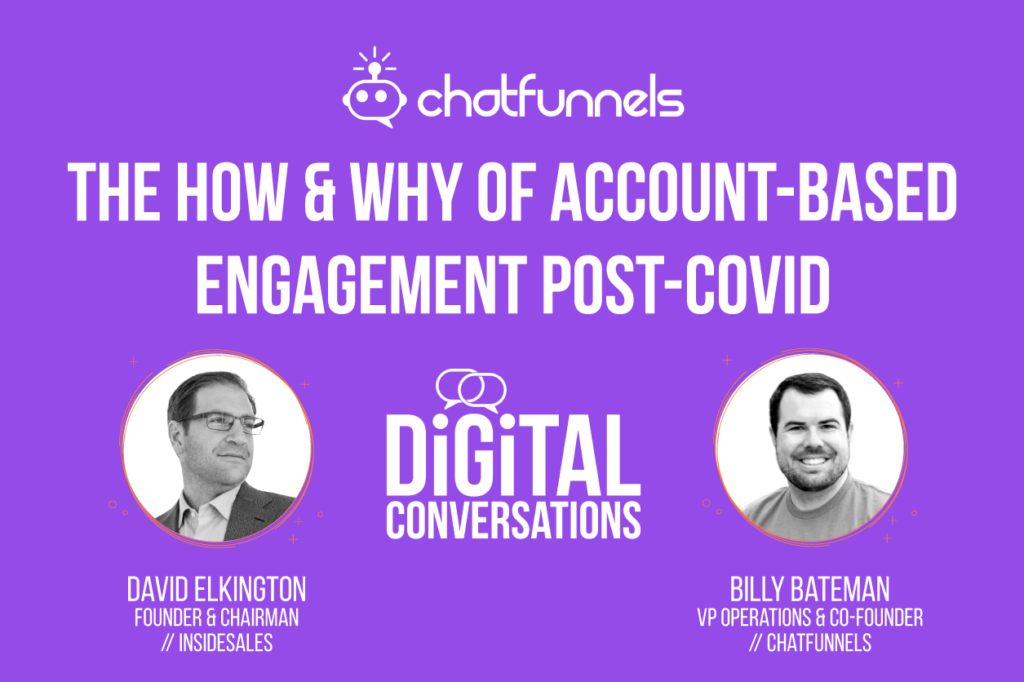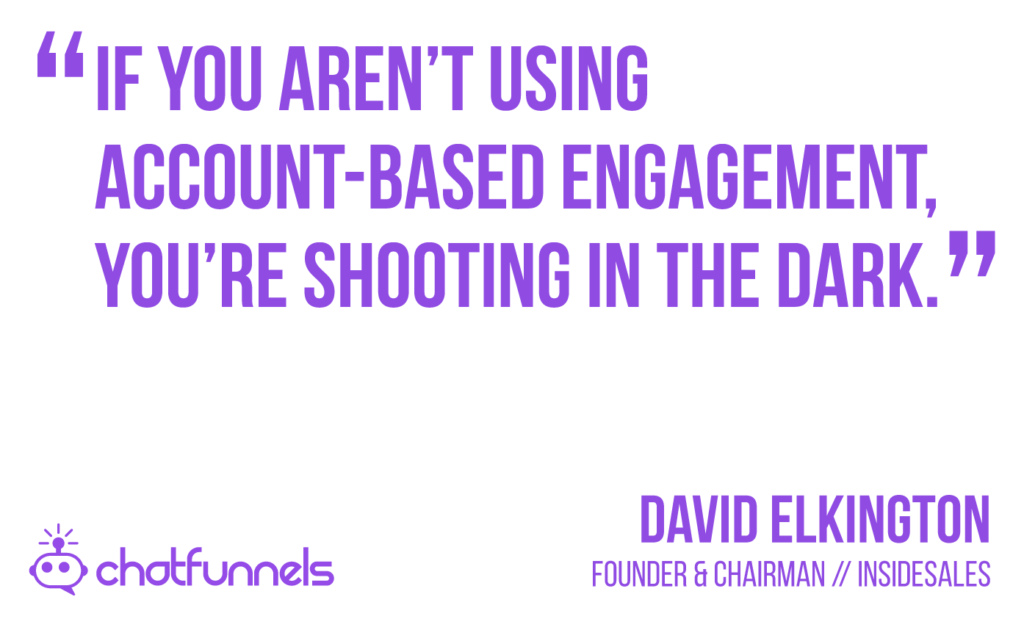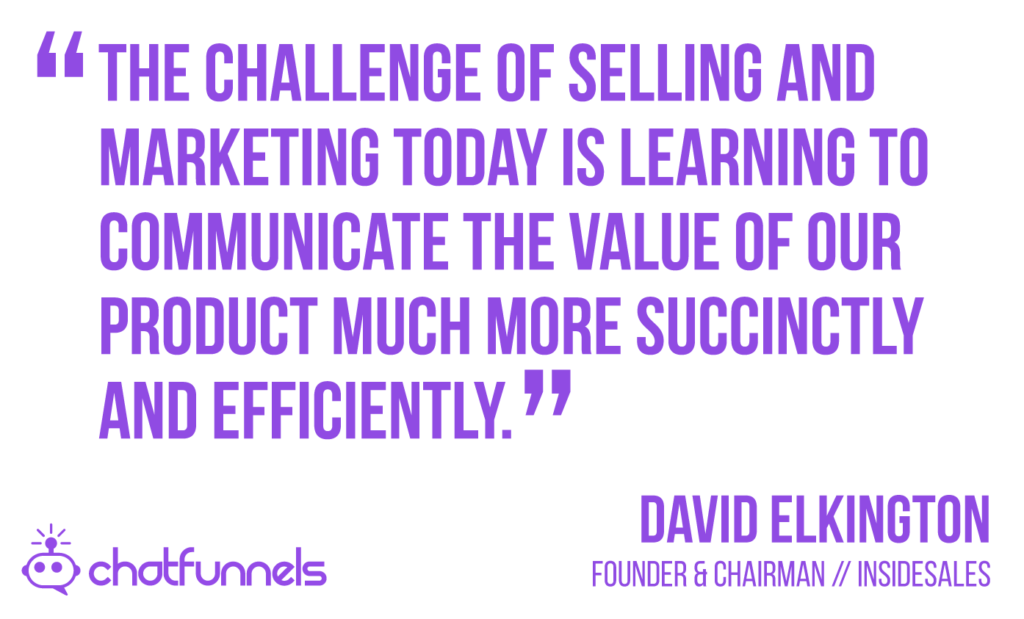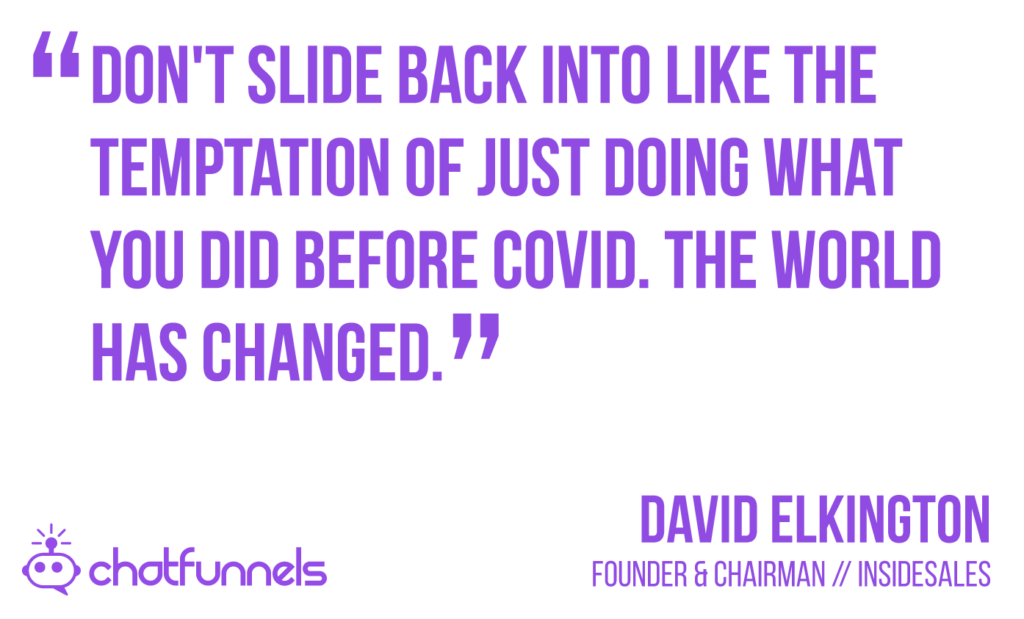The How and Why of Account-Based Engagement Post-COVID with Dave Elkington

Overview: Dave Elkington, Founder and Chairman of InsideSales, discusses how to implement ABE in targeting buying committees digitally.
Guest: Dave Elkington, Founder and Chairman of InsideSales.
Reference:
Transcript
Welcome
Billy Bateman
All right, everyone. Welcome to Digital Conversations. I am your host, Billy Bateman. Today I am joined by the legendary Dave Elkington. Dave, how you doing?
Dave Elkington
I’m better now that I’m on the show just made my maybe my week.
Billy Bateman
Awesome. I’m glad we could do that for you.
Dude, for, for those of you you’ve been on the show a few times, but for anyone that doesn’t know who you are, just give everyone a little intro.

Dave’s Background
Dave Elkington
Yeah, so I, co-founded a company called Inside Sales, we’ve rebranded XANT.
We really created the market around how to use data and process and math and science to respond to kind of digital and marketing generated leads. That’s kind of really the thing in 2009. If you don’t know me, you’ve probably known some of the research in my studies.
Research
We did a study with Professor Oldroyd, who was at MIT at the time, where we identified the need to respond to marketing generated leads within just minutes versus days and weeks.
And I sit on the board here at ChatFunnels, and happy to be involved.
Billy Bateman
Awesome, man. Well, we wanted to talk a little bit about the evolution of solution selling. And so, I just wanted to let’s just start off. You’ve been in the space a long time.
How is Sales Transforming?
What are you seeing is that evolution and solution selling especially like, with COVID, and the digital transformation we’re undergoing? How is solution selling become more digital?
Two Core Buying Models
Dave Elkington
Yeah, it’s an interesting question. The concept of solution selling isn’t necessarily new. So, if you kind of think about the way people buy, there’s really two core buying models.
There’s a consumer buying model and a b2b or business buying model.

Business to Consumer Model
And I think if you think about like, if you just go down to Nordstrom and you’re buying something, or if you’re going to the mall, and you’re buying something, versus your spending $100,000 or a million dollars on a purchase, there’s a few variables that you have to pay attention to. When you think about, selling. One of them is your price point as I just brought up, right. So, if you’re spending a lot of money, you’re going to be very cautious about that spend.
How Complex is your Product?
The second thing is the complexity of what you’re selling. So, and I know we’re kind of getting right into it. But it’s a pretty interesting topic. And it’s actually very relevant as, as you think about what’s happening in marketing, not just sales, but in marketing. And I want to get into that with you in just a minute.
How is your Product Priced?
But if you consider the price of something you’re selling, and then the complexity. So, if you’re just selling bolts, everybody kind of knows what a bolt is. Or if you’re selling cell phone services, right, I’ve got I’ve got my phone right here. People now know what what services are available. I mean, there’s not a lot of variability.
It’s like, oh, I have this screen or that screen. Is the plug in the bottom? Or is it at the top, there’s really not a lot of variables. So, simplicity. And price allows for a very fast purchase process. Which means you don’t need a complex selling process.
Example
On the flip side, if it’s if it’s very expensive, or if it’s very complex, you do. So let me ask you a question. What did you have for lunch yesterday?
Billy Bateman
Some chicken.
Dave Elkington
Okay. How much did you think about that purchase?
Billy Bateman
And not very much?
Buying Decision Making
Dave Elkington
Not much. Okay, so you probably left the office. Before you even knew what you were going to get. You probably made that decision while you were in line. You’re like, the chicken looks good. Well, you didn’t pay that much for the chicken.
I assumed it seemed like a pretty reasonable price a couple bucks. And then you kind of know what chicken tastes like? Like, there’s not a lot of… you kind of know the play.
Larger Purchase Decision
When’s the last time you spent over let’s say $10,000 on something? If you’ll share with the group?
Billy Bateman
Yeah, let me let me think about that. Had to get some surgery that was not covered by insurance. That was $2,000. How much time did you think about that purchase? A couple months before. It wasn’t like I have to do this or I can’t function, but it was like, you probably should do this, is what the doc told me.
Surgery
Oh, yeah. It was probably like three months? Okay. Um, so I met with the doctor probably three times before I was like, okay, let’s just do it. And then talk to a few other people, three or four people that that were not my doctor, but related and they were like, yeah, he’s telling you about the right thing before ultimately doing it.

Consulting Committee
Dave Elkington
I would wager you talk to your wife. I know you’re married. I’d wager you talk to your parents. To get their advice, I would suspect you probably talk to a best friend or two who kind of gave you some advice, and then maybe some of your siblings. Right, so you’re buying committee. To buy chicken, it takes you about 10 seconds to make a decision. To get plastic surgery, just kidding I don’t know what the surgery was.
Billy Bateman
I don’t look good enough to have plastic surgery.
Increasingly Complex Decision Making
Dave Elkington
To get that handsome you, you took 90 days, and probably talked to a half a dozen people, at least that are in your buying committee. So that solution selling and kind of throw the title today, selling is becoming increasingly complex. And it’s because the variety of options of the kind of things that we can buy to solve our problems at work, or at home are increasingly complex, increasingly available increasingly diverse.
Today’s Challenge
And so, the challenges as sellers and as marketers, we have, as we’ve got to learn how to communicate the uniqueness and the difference of our product in a way that can address all of those questions, people have in much faster, succinct, efficient, effective way. Because look, as a seller or a marketer, we want to communicate.
Find your Target Customer
First, we want to be able to, to find the people who are likely to be benefited by our products. And we don’t want to bother people who aren’t interested in it. We’ve got to really understand who our buyers are and who they’re not. And then we’ve got a really short shortcut that process.
Different Selling Processes
If you think about kind of the more traditional Miller Heiman selling process, in that there’s going to be a lot of people, there’s lots of different selling techniques. And if you’ve ever been in sales, you know, like there’s SPIN Selling, there’s solution selling, there’s the challenger sell, there’s Myers Briggs, there’s Miller Heiman. There’s a lot of different methodologies.
Miller Heiman Selling Process
The more complex selling process is like a Miller Heiman selling process where you basically have you identify a buying committee. So, you say okay, well, there’s your coach, the person who wants to buy from you, there’s a person who has the budget, there’s detractors, people, that you need to get approvals essentially from like it, or legal or finance.
Selling to Buying Committees
There’s typically between call it four and 12 people in any kind of buying committee, whether it’s a consumer buying committee, like you had a buying committee to help you make that decision, or b2b buying Committee.
The Digital Shift
The problem with that is now that COVID has come in, especially, (and in the last 10 years, we’ve seen this), but especially with COVID. That buying process, that buying committee is not happening at trade shows, it’s not happening as I come on site to visit, do a site visit. It’s got to happen digitally. So that’s the problem.
Selling Digitally
The problem today, every seller or marketer is faced with this, how do I bridge this gap of engaging and communicating the value uniqueness that you know, of what I sell of my products? digitally, in a way that people. I can build that trust and shorten my sell cycle? And so, here’s an example. What’s a typical b2b website conversion rate? Like you probably know, this number?
The B2B Conversion Rate Problem
Yeah, anywhere from like 2-8% seems to be where people are at. I think that’s a good range. Now, that sounds good. But what basically, you’re spending millions of dollars to get people onto your website, or at least, hundreds of thousands of dollars a year.
Bounced Traffic
That means somewhere between, call it 92-98% of the people you’re spending money to try and communicate with go away. You actually don’t even know who they are, they never come back to your website, you have no engagement with them. So that’s ultimately the problem.
The Need for ABM
So really, there’s what we’re seeing emerge in the market is this ability to communicate with buyers, and especially that buying committee in a digitalized way, and that the label for this thing is called and we’ve seen it in marketing, just a marketing focus side was we’ve seen it called ABM, account-based marketing.
What is ABM?
And really what account-based marketing means is I’m not going to market to you Billy, I’m going to market to the entire account or the entire buying committee. And so basically, if I’m selling into sales, I’ve got to get the sale the CFO, or the VP of sales, I got to get the sales manager, I’ve got to get somebody in finance, engage, I got to get somebody in it engaged. I need to have different messages and different marketing tactics to each of those. But the, the market has moved past.
What is ABE?
Just the marketing, it’s called ABE, account-based engagement. And there’s a great article, we ought to put in your post that that BCG Boston Consulting Group published around this new market or this new approach of ABE or account-based engagement.
Doing Marketing Digitally
And the concept is, whether it’s a lead in the marketing process, if it’s a or a visitor, or if it’s a prospect or an opportunity, somebody who’s actually engaged in the sales process, or if it’s an existing customer, we need to be thinking, account-based engagement, and we need to do it in a digital way. So let me share a couple of the tools. But let me ask you right now.
How Many Touchpoints?
So When your account managers or consultants are engaged with an account or customer, how many different touchpoints do they have? Like, how many different people are they working with?
Billy Bateman
Typically, man, it all depends on the size of the company, like startup, it could be two people they work with. But mid-sized, or even an enterprise customer, man, you’re working with anywhere from 8-20 different people. Like they’re not interacting with all of those people every week, but within a quarter they’re going to interact with at least once those 20 people.
How Much Time to Reach out to a Buying Committee?
Dave Elkington
Okay, so let’s say it’s, it’s 20 people. If you’ve got an account manager we’re not talking in the market, I’m just talking in the account management side of the customer engagement side. Let’s say it’s 12 people they should be engaging with on a monthly basis. How many accounts can that person really manage?
Billy Bateman
If they need if they really are doing that. Man, that is hard to say.
How Much MRR are you Handling?
Dave Elkington
Having them in 10 to 20, maybe if it’s really, 12 people they’ve got to interact with consistently. So, the math, the Bessemer data is it’s roughly they should be managing $2 million of ARR, if it’s in a software or some kind of recurring revenue model.
Is that Manageable? No
What if your deal size is if you’re selling in a large enterprise, and you have 100k, deal sizes, which might be manageable? It’s 20. You know, that’s 20 accounts. But think about that. That means if you have 20 accounts, and you’re engaging with up to 20 people per account, I don’t know how you do that. Yeah. How do you manage? How do you touch base with that many discrete people every month, in a meaningful way, actually don’t think the math works.
The Need for Technology
You have to have technology to do this for so. The technologies that we’re seeing, and it’s emerging, it’s this concept, again, of ABE that that really, BCG coin, and I know you guys are doing a lot of this stuff, we’re seeing a 6sense doing this, ZoomInfo is solving these kinds of problems. We know DemandBase is beginning to solve these kinds of problems.
ChatFunnels using ABE in Conversational Marketing
But you guys, my understanding is really ChatFunnels is really the first in the conversational space. That is really trying to solve this this conversational engagement space.
Steps in ABM
Step 1: Reverse IP Lookup
But the tools, the first thing you have to do is you have to number one, you have to know who is actually on which accounts are engaging in your sites, your products and your sites. Of those people, the 100% of the individuals coming to your website, you need to have a reverse IP lookup tool, you that, that is table stakes.
That’ll tell you is which companies are visiting your site or logging into your products. And it’s not the people you already know, it’s in many cases, it’s the people you don’t you don’t necessarily know.
If you aren’t doing thing, you’re in the dark ages
This helps on the marketing side, the sales side or even the customer engagement side. Yeah, bless you. Thank you for that. So that’s, that’s capability. Number one. If your company is not doing that, then you’re basically just spraying and praying, you’re shooting in the dark.
You’re basically back in the you know, the Dark Ages. Number one, you need to get some kind of reverse IP lookup tool that will tell you that it exposes your dark funnel, the people you don’t know who are on your website. That’s number one.
Step 2: Segment those visitors
Number two. You need to then create a personalized experience for those visitors based off of a segment. You have to segment all of these visitors actually. Number two is the segment the segmentation, you have to say, okay, I’m going to group my visitors into different categories like my customers, my prospects, people, I have opportunities with my target 100, whoever it is, like, these are my hotlist.
Identify Visitors with Reverse IP Lookup
Yep, my investors, my employees, my family members, like their work, you know, whatever, like there’s categories of people that you would want to have a different experience when they come on your website. So again, identification, reverse IP tools, things like that. Number two, you need to go to the work of segmentation.
Step 2: Identify Potential Customers
Number three, what you’re going to want to do is you’re also going as a subset of your segmentation, you want to know who can buy from you. It’s a simple exercise. Go to your existing cut your customer base, and just profile them.
You’d say, look, what you’re going to learn out of this is we sell really well into the following industries, we sell really well into the following geographies, we sell really well into the following revenue segments or employee count segments.
Step 3: Categorize by Geography, Revenue/Employee Count, Industry
Because just because we want to sell to enterprise, we may not be good at it, we may be really good at selling to, you know, mid-market or micro market. And so just take, it’s a simple exercise, take your entire customer base, and go categorize three things. They’re geographies, number one, number two, their site by revenue, and by employee count, and three by industry like that. Go find where your clusters are.
Create Personalized Experiences
And what you want to do is you want to go create personalized experiences for those clusters. Meaning if somebody in the healthcare industry in the mid-market space is on your website, or using your product, you want to make sure that they experience it in a way that’s specific to them, that increases the likelihood they understand your value. So that’s number three.
Step 4: Create Personalized Experiences
Number four, you then go create those experiences. And one thing that I’ve seen you do and we’re seeing other organizations begin to do is alter the website experience.
I know that you can create custom conversations, custom bots, custom experiences based off of these segments. So that’s the fourth thing you do is create custom experiences for those organizations. And then you want to create custom follow up which is number five, follow up custom reach out.
Selling to Committees
So again, think that that complex Miller Heiman selling approach where you’ve got people who are in the IT segment of your again, back to my example, healthcare mid-market, North America, midway backwards, go Midwest, okay.
Then you go one step below, and you say, okay, well, now we have a company who’s on our website, which is mid-market, health care Midwest, and I have someone in the IT segment, okay, I want to communicate a message to someone, and because they represent an
Customized Messaging for Different Roles
approval role I need, they tend to be, you know, detractors or blockers from our solution. I’m going to change my messaging, or my or their experience, completely from a budget holder, or completely from someone who’s going to be a coach of ours on their website.
So really go that’s kind of your last step is create custom experiences, all the way down to the buying role for that individual. And that and think about that, from a customer perspective.
Give Personalized Web Experiences
If one of your customers is on your website, and you know that they’re in it. Well, you want to make sure that they experience something very different than if it’s the person who’s going to be writing the check.
So, the whole new world of ABE allows people or account-based engagement allows people to create very customized experiences that have been extremely manual. Not new, don’t get me wrong, like this concept has been around for, you know, 40 years. Yep. But we’re now that the tools are now available to do this digitally.
And it’s, it’s pretty much now being forced on us.
Effects of COVID
Because of COVID. We can’t do it. Now the great news is because we can do it digitally and the tools are now available are costs around managing customers. The efficiency is now going through the roof. If you think about it, because instead of only being able to manage, call it 5-10 customers.
The Need for Technology
Or I can only engage with call it a dozen opportunities or prospects. I can now do it at scale, I can do 40 or 50. And I can do it super efficiently with tools like this. So that’s, that’s I know, a bit of a monologue, but I think the whole world is changing right now.
Billy Bateman
I agree. I agree. It’s the ability to really customize that experience on the website. It pays off, it pays off for you.
Personalizing for Individuals- Not a good idea
Your customers, they feel like you don’t want to personalize down to the individual level necessarily, that’s kind of creepy. But at the account level, and knowing Hey, this is a group, and this is how this group responds, dude, the results are great.
Dave Elkington
I was going to say, Yeah, one of the worst things you can do is say hi, yeah. “Hi, Billy!” Yeah, hire you. Like that kind of stuff. People started to do that. And it’s terrible. The thing I would say is on all of these tools, be straightforward.
Building Trust
The worst thing you can do is betray trust. And by doing that is lying, trying to show that you’re a bot, or you’re a human when you’re a bot. Or you know, something you don’t just be in all of these technologies. Be honest, be very, very straightforward.
Billy Bateman
Agreed. Agreed. And then when you do that, like, “hey Billy!” I feel like 80% of the time it gets it wrong. Anyway. I know.
Yeah, I get it gets it wrong. So oh, man. Well, I’ve learned a ton. Is there anything else we should, we should touch base on before, before we break this off?
Don’t go back to pre-COVID Strategies
Dave Elkington
Now, the only thing I would say is like, because of what’s happened with COVID, the world has changed. Don’t get stuck in the trap of saying, okay, COVID is now starting to ramp down. Let’s get back. Let’s get back to how it was like the how it was is gone.
Don’t slide back into like the temptation to be like, okay, I can just do what I used to do. force yourself, disrupt yourself be like, as a marketer, as a sales leader. Like you, you got to think differently, you have to you, yeah, find the opportunity. And if you do it, you’ll be way ahead of your competition.
Continue to Innovate
Billy Bateman
Yeah, if you keep innovating here, the other things are going to open back up, you know, trade shows, events, go back, do those things still. But there’s still a lot of a lot of innovation happens just on the website, the digital experience, so exactly where you’re going to get ahead because everyone’s going to go back and start doing the trade shows once they’re once they’re open again.
Dave Elkington
don’t fall into that trap.
Wrap-up
Billy Bateman
Oh, hey, Dave. I always learn a lot when we talk and really appreciate it. Cool.
Dave Elkington
Thanks for having me on Billy.
Billy Bateman
Okay. We’ll chat later.
